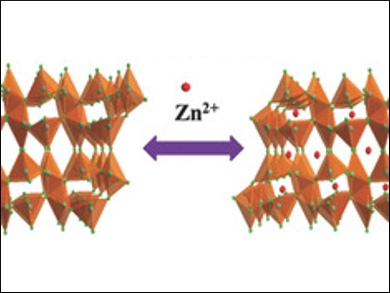Rechargeable zinc-ion batteries with aqueous electrolytes could be a safe, low-cost, and environmentally friendly alternative to other commercially available batteries. However, there is a lack of suitable cathode materials with high rate capabilities.
Shubin Yang, Beihang University, Beijing, China, and colleagues have found that vanadium dioxide nanofibers in the VO2 (B) phase can intercalate Zn2+ ions with ultrafast kinetics and, thus, can act as the cathode material with a very high rate capability for zinc-ion batteries. The team synthesized VO2 (B) nanofibers using a hydrothermal approach and used them in a zinc-ion battery with an aqueous Zn(CF3SO3)2 electrolyte.
The vanadium dioxide phase used is composed of distorted VO6 octahedra which form tunnel-like frameworks (pictured). These tunnels offer pathways for the fast transport of Zn2+ ions, with little structural change on Zn2+ intercalation. Thus, VO2 (B) nanofibers exhibit a high reversible capacity of 357 mAh g−1, a high rate capability of 171 mAh g−1 at 300 C, and high energy- and power densities for zinc-ion storage.
- Ultrafast Zn2+ Intercalation and Deintercalation in Vanadium Dioxide,
Junwei Ding, Zhiguo Du, Linqing Gu, Bin Li, Lizhen Wang, Shiwen Wang, Yongji Gong, Shubin Yang,
Adv. Mater. 2018.
https://doi.org/10.1002/adma.201800762



